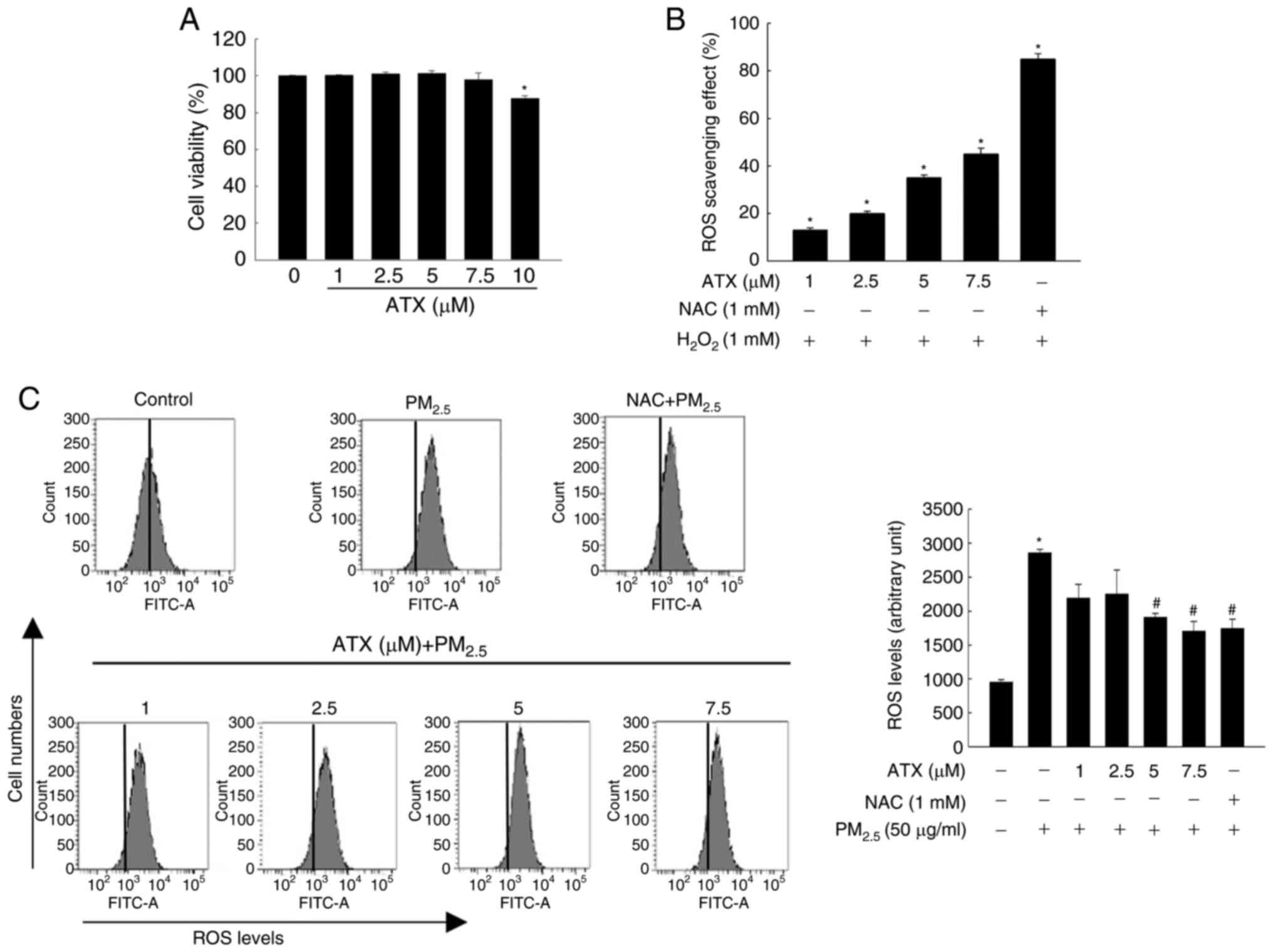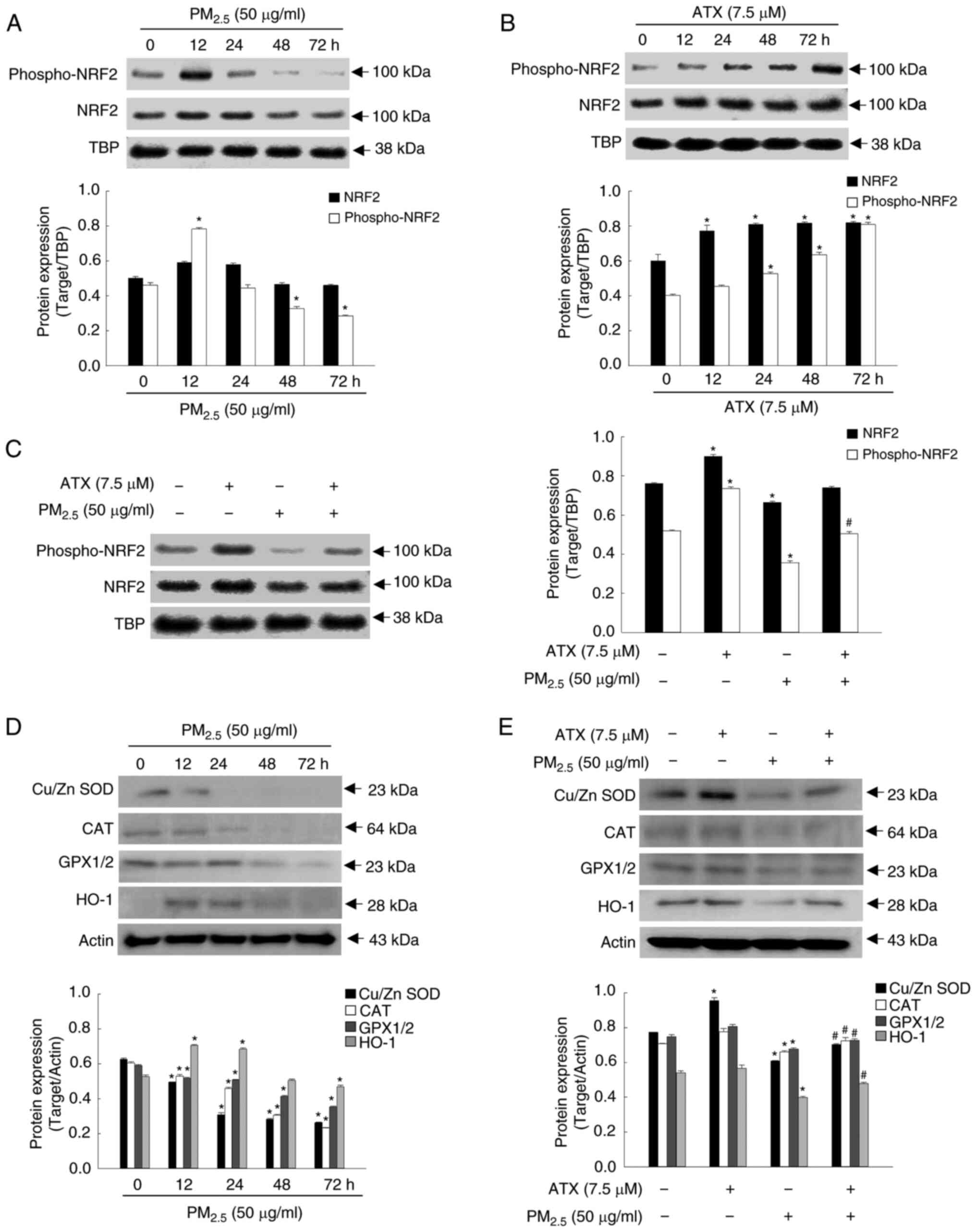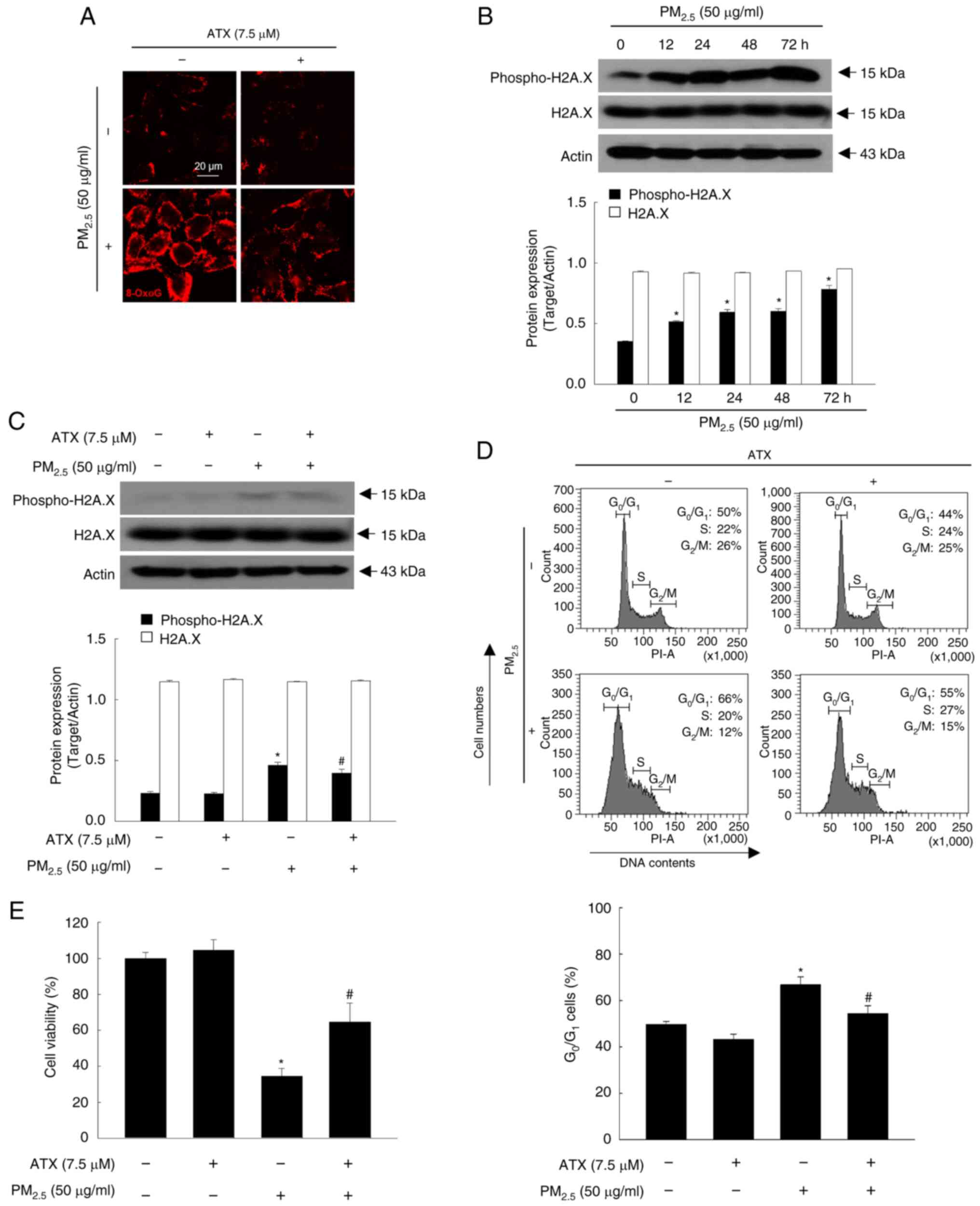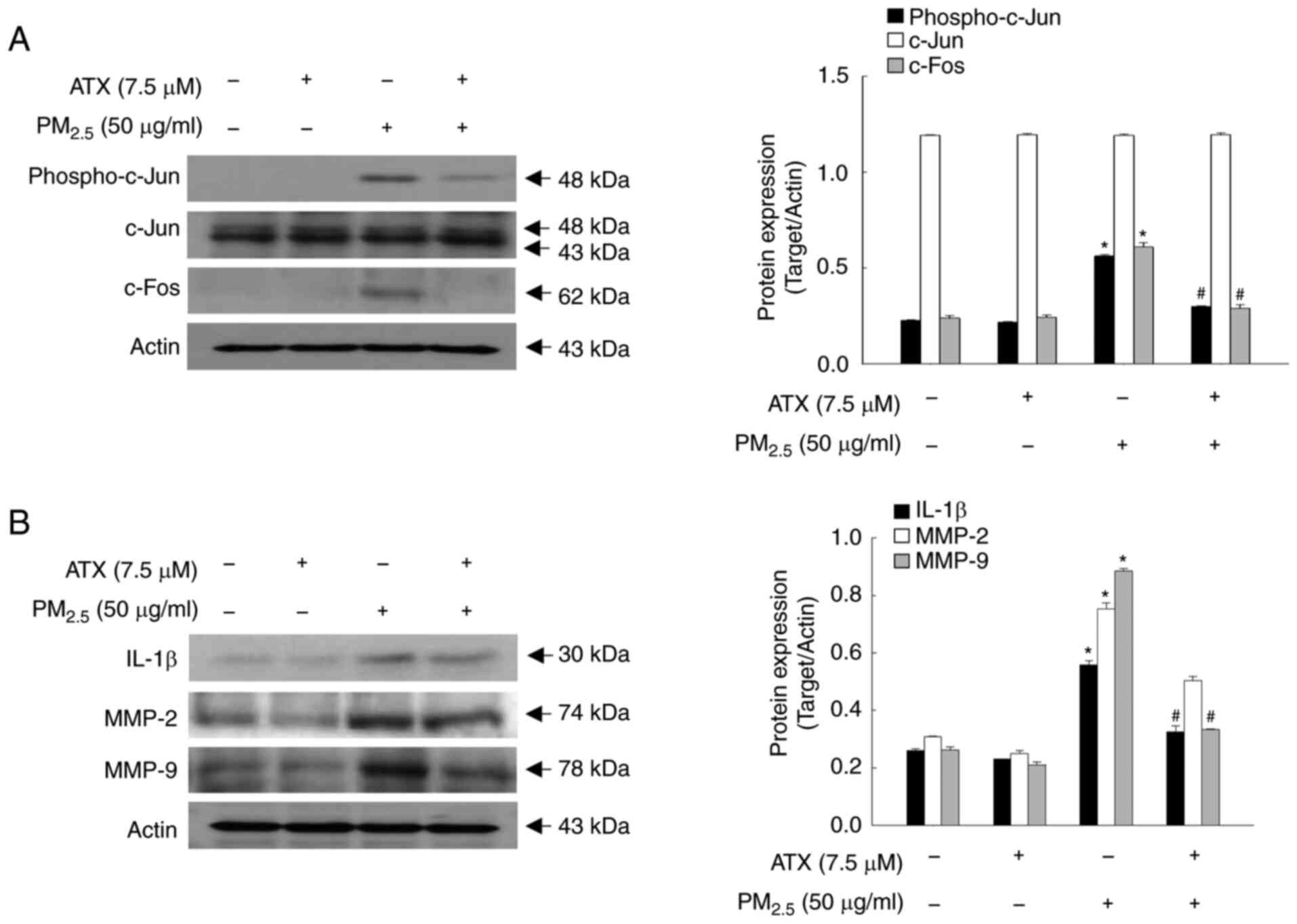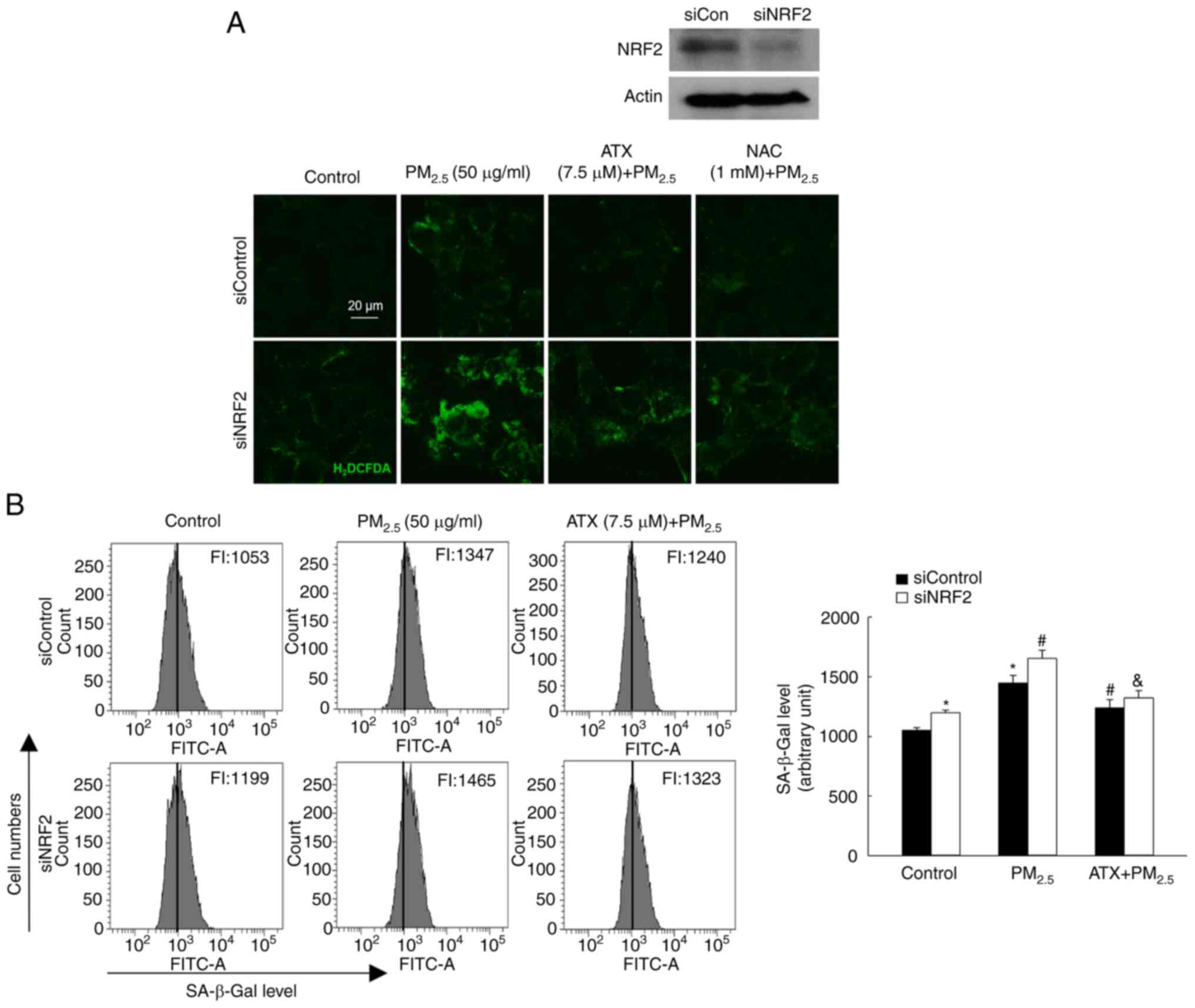|
1
|
Lelieveld J, Evans JS, Fnais M, Giannadaki
D and Pozzer A: The contribution of outdoor air pollution sources
to premature mortality on a global scale. Nature. 525:367–371.
2015.PubMed/NCBI View Article : Google Scholar
|
|
2
|
Boogaard H, Patton AP, Atkinson RW, Brook
JR, Chang HH, Crouse DL, Fussell JC, Hoek G, Hoffmann B, Kappeler
R, et al: Long-term exposure to traffic-related air pollution and
selected health outcomes: A systematic review and meta-analysis.
Environ Int. 164(107262)2022.PubMed/NCBI View Article : Google Scholar
|
|
3
|
Ryu YS, Kang KA, Piao MJ, Ahn MJ, Yi JM,
Hyun YM, Kim SH, Ko MK, Park CO and Hyun JW: Particulate matter
induces inflammatory cytokine production via activation of NFκB by
TLR5-NOX4-ROS signaling in human skin keratinocyte and mouse skin.
Redox Biol. 21(101080)2019.PubMed/NCBI View Article : Google Scholar
|
|
4
|
Piao MJ, Ahn MJ, Kang KA, Ryu YS, Hyun YJ,
Shilnikova K, Zhen AX, Jeong JW, Choi YH, Kang HK, et al:
Particulate matter 2.5 damages skin cells by inducing oxidative
stress, subcellular organelle dysfunction, and apoptosis. Arch
Toxicol. 92:2077–2091. 2018.PubMed/NCBI View Article : Google Scholar
|
|
5
|
Hyun YJ, Piao MJ, Kang KA, Zhen AX,
Madushan Fernando PDS, Kang HK, Ahn YS and Hyun JW: Effect of
fermented fish oil on fine particulate matter-induced skin aging.
Mar Drugs. 17(61)2019.PubMed/NCBI View Article : Google Scholar
|
|
6
|
Reynolds WJ, Hanson PS, Critchley A,
Griffiths B, Chavan B and Birch-Machin MA: Exposing human primary
dermal fibroblasts to particulate matter induces changes associated
with skin aging. FASEB J. 34:14725–14735. 2020.PubMed/NCBI View Article : Google Scholar
|
|
7
|
Mendonça ELSS, Xavier JA, Fragoso MBT,
Silva MO, Escodro PB, Oliveira ACM, Tucci P, Saso L and Goulart
MOF: E-stilbenes, general chemical and biological aspects,
potential pharmacological activity based on the Nrf2 pathway.
Pharmaceuticals (Basel). 17(232)2024.PubMed/NCBI View Article : Google Scholar
|
|
8
|
Zhang LM, Lv SS, Fu SR, Wang JQ, Liang LY,
Li RQ, Zhang F and Ma YX: Procyanidins inhibit fine particulate
matter-induced vascular smooth muscle cells apoptosis via the
activation of the Nrf2 signaling pathway. Ecotoxicol Environ Saf.
223(112586)2021.PubMed/NCBI View Article : Google Scholar
|
|
9
|
Kahremany S, Hofmann L, Eretz-Kdosha N,
Silberstein E, Gruzman A and Cohen G: SH-29 and SK-119 attenuates
air-pollution induced damage by activating Nrf2 in HaCaT cells. Int
J Environ Res Public Health. 18(12371)2021.PubMed/NCBI View Article : Google Scholar
|
|
10
|
Han SI, Chang SH, Lee C, Jeon MS, Heo YM,
Kim S and Choi YE: Astaxanthin biosynthesis promotion with pH shock
in the green microalga, Haematococcus lacustris. Bioresour Technol.
314(123725)2020.PubMed/NCBI View Article : Google Scholar
|
|
11
|
Kumar S, Kumar R, Diksh Kumari A and
Panwar A: Astaxanthin: A super antioxidant from microalgae and its
therapeutic potential. J Basic Microbiol. 62:1064–1082.
2022.PubMed/NCBI View Article : Google Scholar
|
|
12
|
Ashrafizadeh M, Ahmadi Z, Yaribeygi H,
Sathyapalan T and Sahebkar A: Astaxanthin and Nrf2 signaling
pathway: A novel target for new therapeutic approaches. Mini Rev
Med Chem. 22:312–321. 2022.PubMed/NCBI View Article : Google Scholar
|
|
13
|
Imokawa G: Intracellular signaling
mechanisms involved in the biological effects of the xanthophyll
carotenoid astaxanthin to prevent the photo-aging of the skin in a
reactive oxygen species depletion-independent manner: The key role
of mitogen and stress-activated protein kinase 1. Photochem
Photobiol. 95:480–489. 2019.PubMed/NCBI View Article : Google Scholar
|
|
14
|
Zhen AX, Piao MJ, Hyun YJ, Kang KA,
Madushan Fernando PDS, Cho SJ, Ahn MJ and Hyun JW:
Diphlorethohydroxycarmalol attenuates fine particulate
matter-induced subcellular skin dysfunction. Mar Drugs.
17(95)2019.PubMed/NCBI View Article : Google Scholar
|
|
15
|
Matthews HK, Bertoli C and de Bruin RAM:
Cell cycle control in cancer. Nat Rev Mol Cell Biol. 23:74–88.
2022.PubMed/NCBI View Article : Google Scholar
|
|
16
|
Hernandez-Segura A, Nehme J and Demaria M:
Hallmarks of cellular senescence. Trends Cell Biol. 28:436–453.
2018.PubMed/NCBI View Article : Google Scholar
|
|
17
|
Oh JH, Joo YH, Karadeniz F, Ko J and Kong
CS: Syringaresinol inhibits UVA-induced MMP-1 expression by
suppression of MAPK/AP-1 signaling in HaCaT keratinocytes and human
dermal fibroblasts. Int J Mol Sci. 21(3981)2020.PubMed/NCBI View Article : Google Scholar
|
|
18
|
Samdavid Thanapaul RJR, Shvedova M, Shin
GH, Crouch J and Roh DS: Elevated skin senescence in young mice
causes delayed wound healing. Geroscience. 44:1871–1878.
2022.PubMed/NCBI View Article : Google Scholar
|
|
19
|
Ryu YS, Kang KA, Piao MJ, Ahn MJ, Yi JM,
Bossis G, Hyun YM, Park CO and Hyun JW: Particulate matter-induced
senescence of skin keratinocytes involves oxidative
stress-dependent epigenetic modifications. Exp Mol Med. 51:1–14.
2019.PubMed/NCBI View Article : Google Scholar
|
|
20
|
Zhen AX, Piao MJ, Kang KA, Fernando PD,
Herath HM, Cho SJ and Hyun JW: 3-Bromo-4,5-dihydroxybenzaldehyde
protects keratinocytes from particulate matter 2.5-induced damages.
Antioxidants (Basel). 12(1307)2023.PubMed/NCBI View Article : Google Scholar
|
|
21
|
Wang L, Lee W, Jayawardena TU, Cha SH and
Jeon YJ: Dieckol, an algae-derived phenolic compound, suppresses
airborne particulate matter-induced skin aging by inhibiting the
expressions of pro-inflammatory cytokines and matrix
metalloproteinases through regulating NF-κB, AP-1, and MAPKs
signaling pathways. Food Chem Toxicol. 146(111823)2020.PubMed/NCBI View Article : Google Scholar
|
|
22
|
Ma C, Yang K, Wang Y and Dai X: Anti-aging
effect of agar oligosaccharide on male Drosophila melanogaster and
its preliminary mechanism. Mar Drugs. 17(632)2019.PubMed/NCBI View Article : Google Scholar
|
|
23
|
Liu XY, Liu D, Lin GP, Wu YJ, Gao LY, Ai
C, Huang YF, Wang MF, El-Seedi HR, Chen XH and Zhao C: Anti-ageing
and antioxidant effects of sulfate oligosaccharides from green
algae Ulva lactuca and Enteromorpha prolifera in SAMP8 mice. Int J
Biol Macromol. 139:342–351. 2019.PubMed/NCBI View Article : Google Scholar
|
|
24
|
Sorrenti V, Davinelli S, Scapagnini G,
Willcox BJ, Allsopp RC and Willcox DC: Astaxanthin as a putative
geroprotector: Molecular basis and focus on brain aging. Mar Drugs.
18(351)2020.PubMed/NCBI View Article : Google Scholar
|
|
25
|
Chen Z, Xiao J, Liu H, Yao K, Hou X, Cao Y
and Liu X: Astaxanthin attenuates oxidative stress and immune
impairment in D-galactose-induced aging in rats by activating the
Nrf2/Keap1 pathway and suppressing the NF-κB pathway. Food Funct.
11:8099–8111. 2020.PubMed/NCBI View Article : Google Scholar
|
|
26
|
Herath HMUL, Piao MJ, Kang KA, Zhen AX,
Fernando PDSM, Kang HK, Yi JM and Hyun JW: Hesperidin exhibits
protective effects against PM2.5-mediated mitochondrial damage,
cell cycle arrest, and cellular senescence in human HaCaT
keratinocytes. Molecules. 27(4800)2022.PubMed/NCBI View Article : Google Scholar
|
|
27
|
Kumari R and Jat P: Mechanisms of cellular
senescence: Cell cycle arrest and senescence associated secretory
phenotype. Front Cell Dev Biol. 9(645593)2021.PubMed/NCBI View Article : Google Scholar
|
|
28
|
Zhou Q, Wang W, Wu J, Qiu S, Yuan S, Fu
PL, Qian QR and Xu YZ: Ubiquitin-specific protease 3 attenuates
interleukin-1β-mediated chondrocyte senescence by deacetylating
forkhead box O-3 via sirtuin-3. Bioengineered. 13:2017–2027.
2022.PubMed/NCBI View Article : Google Scholar
|
|
29
|
Chen L, Yang R, Qiao W, Zhang W, Chen J,
Mao L, Goltzman D and Miao D: 1,25-Dihydroxyvitamin D exerts an
antiaging role by activation of Nrf2-antioxidant signaling and
inactivation of p16/p53-senescence signaling. Aging Cell.
18(e12951)2019.PubMed/NCBI View Article : Google Scholar
|
|
30
|
Lee JJ, Ng SC, Hsu JY, Liu H, Chen CJ,
Huang CY and Kuo WW: Galangin reverses
H2O2-induced dermal fibroblast senescence via
SIRT1-PGC-1α/Nrf2 signaling. Int J Mol Sci. 23(1387)2022.PubMed/NCBI View Article : Google Scholar
|
|
31
|
Kumar N, Reddi S, Devi S, Mada SB, Kapila
R and Kapila S: Nrf2 dependent antiaging effect of milk-derived
bioactive peptide in old fibroblasts. J Cell Biochem.
120:9677–9691. 2019.PubMed/NCBI View Article : Google Scholar
|



